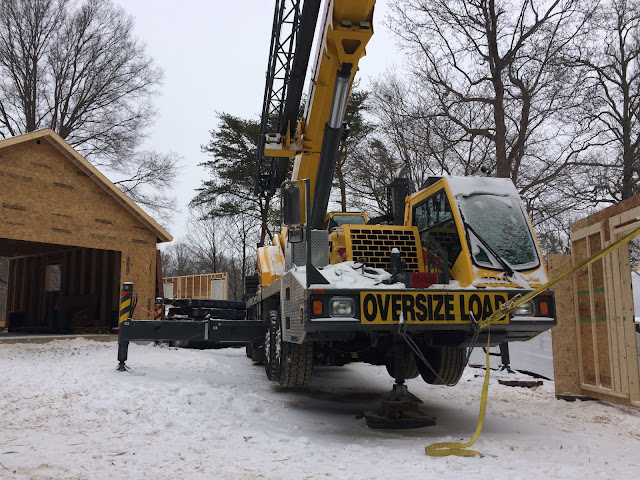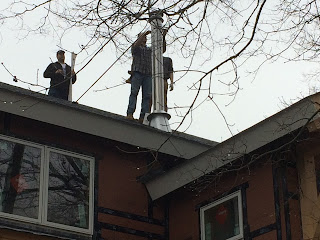The basement and garage slabs were poured yesterday. Four truckloads of concrete were delivered for the job. The basement has two layers of 2 inch Owens Corning Foamular 250 rigid insulation, with Steggo moisture barrier (the yellow sheet) between the layers. It is fall and a lot of leaves fell into the basement over the weekend. I used a leaf blower/vacuum to suck up most of the leaves Sunday afternoon before the Monday pour. The copper sheathing along the top of the foundation is there as part of the jig to make sure the steel beam down the center is the proper height.
 |
| Ready for the pour |
They used a laser transit to determine the height of the concrete slab and get it level. They would level a spot every 6 ft or so and then use a long board or a vibrating metal strip to smooth and level the concrete between the measured spots.
 |
| Pouring the basement slab |
The concrete pump truck is a pretty interesting piece of equipment. I'm sure it is expensive. But it certainly beats using rakes, shovels, and wheelbarrows to move concrete around. It is still a job that requires some effort.
 |
| The pump truck makes placing the concrete relatively easy |
Then it was time to pour the garage slab. They used rebar to mark the height of the garage floor, since it doesn't need a watertight membrane below its slab. The pump truck operator is standing to the left in the hard hat. He has a wireless remote control that has two joysticks, a display, and a bunch of switches. There's a small horn that he and the concrete truck driver use to signal each other about the concrete supply. For example, the concrete truck driver signals when the truck is empty so that the pump operator knows to stop pumping. The pump truck uses two big rams (6 inch diameter about 5 ft long) and a big valve to pump the concrete.
 |
| Pouring the garage slab |
The concrete crew had started floating the basement slab just before I left the job site. The mechanical rotation polishers certainly make this job easier. The act of floating drives the aggregate below the surface and smooths the surface cement. They have to wait until the concrete starts to set before floating.
 |
| Mechanical float |
Next up is the foundation sill plate and setting the replacement 25' 4" steel beam that replaces the short beam that was delivered last week. We're going to need a crane to set the beam and to load the short beam on the delivery truck to go back to the shop. With this expense, the steel company isn't going to make money on this job. I'm guessing that they skipped the "measure twice by two different people" process to eliminate mistakes in the fabrication shop.







Comments
Post a Comment